After two weeks of retreats, the gold market (XAU/USD) has started the new trading period attempting to solidify a crucial base around the $4,000 psychological level. While a recovering US dollar and diminishing safe-haven demand have pushed prices back from recent highs, analysts suggest the dip was “long overdue” and, more importantly, the metal’s powerful long-term uptrend remains intact.
The $4,000 Question: Pause or Peak?
Gold’s recent performance has been characterized by waning momentum after reversing from heavily overbought, record levels. The temporary breach of the $4,000 mark triggered a wave of technical selling and profit-taking. However, the subsequent move back above this key level offers a mildly encouraging sign to bulls.
The market now faces a fundamental question: is this a short-term pause before another leg higher, or has the peak been reached? The answer hinges primarily on two major external forces:
- The US Dollar’s Direction: A strengthening dollar makes gold more expensive for foreign buyers, acting as a headwind.
- Central Bank Demand: Continued large-scale, strategic buying by global central banks provides a crucial, non-speculative floor for prices.
Headwinds: Easing Tensions and Soaring Stocks
Several factors are currently dampening gold’s appeal as a safe-haven asset:
- Geopolitical Calm: The recent easing of US-China trade tensions has reduced the incentive to seek shelter in gold.
- Monetary Caution: A less-than-certain stance from the Federal Reserve Chair on a near-term interest rate cut has tempered expectations for immediate policy easing.
- Risk-On Rally: With global equity indices reaching fresh record highs, capital is naturally flowing into riskier assets, dimming the need for traditional safe havens.
🇨🇳 China’s Demand: A Temporary Hiccup, Not a Fundamental Shift
One of the most powerful drivers of gold’s historic rally has been robust central bank accumulation, particularly from institutions looking to diversify away from US dollar assets.
Recent figures from Hong Kong, however, indicate a moderation in buying, with net exports of gold to China dropping 17.6% month-on-month in September. This softening demand is likely a reaction to the metal’s persistently elevated prices this year, rather than a sign of a fundamental change in long-term diversification policy by the People’s Bank of China (PBOC). With imports still substantial (over 22 tonnes), the market is awaiting official PBOC data for a clearer picture.
Technical Outlook: The Rally’s Foundation Is Deep
Despite the short-term pressure, the long-term trend for gold remains bullish. Betting against the rally has proven unprofitable for over a year, making a definitive call on a peak premature.
If gold can stabilize and hold firmly above $4,000, it will strongly reinforce the view that the multi-year uptrend is still intact. Should it fail to maintain this critical floor, however, it could signal a short-term top, opening the door for further technical declines toward initial support levels at $3,970 and then last week’s low of $3,886, where it may find a renewed pool of buyers.
For now, the battle at $4,000 is key, but the structural forces—namely long-term central bank strategy and geopolitical uncertainty—suggest the yellow metal’s long-term climb is far from over.

